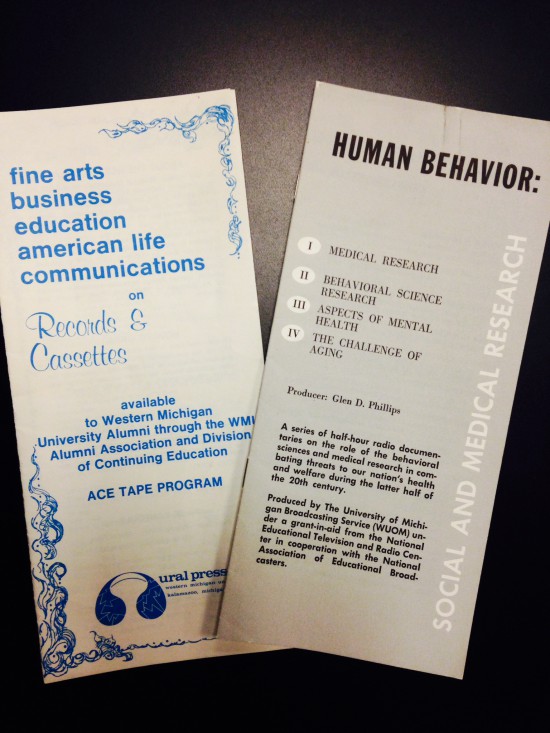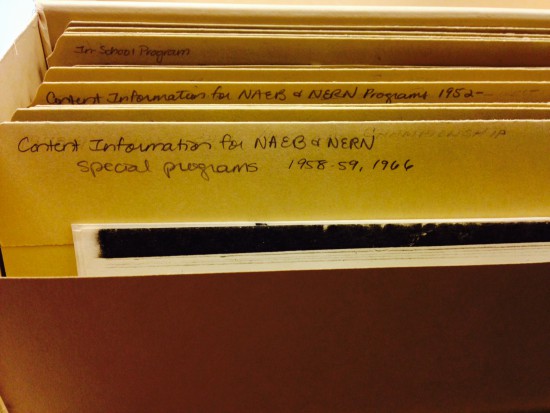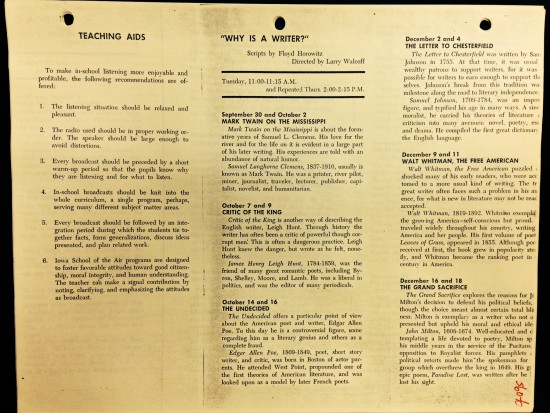Audiovisual Archives and the Context Conundrum

Distribution brochures for instructional radio series, from the paper archives of the National Association of Educational Broadcasters (NAEB) at University of Maryland
Post by Stephanie Sapienza, Project Manager at the Maryland Institute for Technology in the Humanities (MITH)
Historical collections of audiovisual material are housed at repositories of an extraordinarily varied nature: within museums, libraries, historical societies, private collections; within media production units; and within traditional archives (only a small percentage of which are specifically dedicated to audiovisual collections). Archival paper collections are certainly more ubiquitous across all these institutions and more, representing the vast majority of the overall archival record.
As someone who has utilized, studied, worked in, and then managed projects related to audiovisual archives, there’s a trend I’ve been tracking for some time which continues to vex me. This trend relates to a very common scenario – split collections of media and related paper/textual collections – which are accepted into archival repositories and then, for lack of a better analogy, “separated at birth.” The collections are accessioned, and then broken apart and processed using very different and separate techniques, guidelines, and description schemas. Quite often, the two collections never get near each other again – physically or ontologically.
I will try to succinctly break down how this phenomenon occurs. Archival institutions often utilize a traditional description approach for paper-based materials such as transcripts, production and field recording notes, press kits, photos, correspondence, provenance and copyright materials. This usually results in an online finding aid. Conversely, institutions with significant audiovisual holdings traditionally favor an item-level approach, often with the aim of preparing for a preservation effort which requires metadata on item condition, formats, etc. Often the “split but related mixed media collections” scenario occurs within an institution that holds both paper and media materials, yet processes them differently and in different departments. Other times, as with the case study I’d like to discuss, the paper and media collections are also geographically separated.
The National Association of Educational Broadcasters (NAEB) historic radio collection spans the breadth of twentieth century mass media. Throughout its 60 years of existence, the NAEB ushered in or helped to enable major changes in early educational broadcasting policy. The NAEB audio collection, now fully digitized through a collaboration with the American Archive of Public Broadcasting, is held at the University of Maryland Libraries and represents the archives of the radio programming service of the organization, known as the National Educational Radio Network (NERN). The paper materials, comprising correspondence, reports, clippings, speeches and more, remain at the Wisconsin Historical Society. The finding aid for the NAEB paper collection alone reveals that it contains a depth of contextual information relevant to the study of the tape collection. Digitized paper materials would reveal even more.
For example, The Jeffersonian Heritage, a 1952 series of 13 half-hour radio programs, was recorded by the National Association of Educational Broadcasters and syndicated for commercial-free broadcast. Funded by a Ford Foundation grant, The Jeffersonian Heritage starred English-born actor Claude Rains, made famous by appearances in The Invisible Man, Mr. Smith Goes to Washington, Casablanca, and Alfred Hitchcock’s Notorious. An attempt to create radio that could be both “educational and appealing,” The Jeffersonian Heritage began its first series by educating the public about Thomas Jefferson’s attempt to have an anti-slavery clause written into the U.S. Constitution. With subsequent episodes attempting to tie themes from Jefferson’s personal and political history to contemporary events, The Jeffersonian Heritage provides a rich vein of material for explorations of how mid-twentieth century Americans engaged in remembrances of an agrarian past. How was Thomas Jefferson presented through the lens of anxieties about America’s place within the Cold War world? How were these episodes marketed and promoted to the public?*
To gain an accurate picture of the importance of these broadcasts, researchers would need to understand not just the content of the broadcast but also the circumstances of its production and its reception. For starters, the NAEB paper collections contain a brochure which reveals that the series was marketed by Aural Press of Western Michigan University as part of an “American Life Series” alongside other program series such as “Patterns in Pop Culture,” “Women,” “Abortion,” “Sounds of Poverty,” “Censorship,” and “The Nostalgia Merchants.” Placing one highly specific (and dramatic) series in context alongside such broadly-conceived topical documentary programs indicates that it held a certain level of specialized merit as an individual historical record.
A speech by former NAEB Chair William Harley which says the following about The Jeffersonian Heritage: “In 1951 we produced a dramatic history series called The Jeffersonian Heritage starring Claude Rains as Jefferson; a dramatic series on cultural anthropology called ‘Ways of Mankind’ and a series produced in conjunction with the Russian Institute at Harvard called ‘People Under Communism.’ The significance of this project is that our products convinced Scotty and his Board that educators were professionally competent and deserved support as they ventured into the new field of television. Thus did educational radio help the launching of educational television, for the Fund for Adult Education and later the Ford Foundation itself poured millions of dollars into projects fostering the start of education television.”
The above two pieces of contextual detail were uncovered only from the two small boxes of paper material that was retained with the audio collection at UMD. The Wisconsin finding aid reveals two additional folders of information on this series, which could unearth a great deal more contextual information which is ripe with potential for teaching curricula or individual scholarly research.
A second example is the series Why is a Writer?, which originally aired from 1960-61. The individual media records for the series contain the following description: “Produced by the Iowa School of the Air, this series focuses on various works of literature from Shakespeare to Twain.” The description for one individual program, “Critic of the king,” has an additional program description: “This program focuses on English writer Leigh Hunt, also known as James Henry Leigh Hunt.”
UMD has, by all means, a very richly descriptive individual record for this one individual program recording – even to have two separate descriptions (one for the series as a whole and one for the program) is uncommon in most descriptive catalogs.
A cursory search in the NAEB paper archives unlocked the following information:
In 1967-67, several years after it originally aired, Why is a Writer was still being distributed to educators throughout the country through Iowa School of the Air, along with teaching aids and instructions on how to teach the material. This teaching aid included instructions for educators such as “Every broadcast should be preceded by a short warm-up period so that the pupils know why they are listening to and what to listen,” and “Every broadcast should be followed by an integration period during which the students tie together facts, form generalizations, discuss ideas presented, and plan related work.” Additionally, the teaching aid contains a much more detailed program description for “Critic of the King:” “‘Critic of the King’ is another way of describing the English writer Leigh Hunt. Through history the writer has often been a critic of powerful through corrupt men. This is often a dangerous practice. Leigh Hunt knew the danger, but wrote as he felt, nonetheless. James Henry Leigh Hunt, 1784-1859, was the friend of many great romantic poets, including Byron, Shelley, Moore, and Lamb. He was a liberal in politics and was the editor of many periodicals.”
Why is a Writer shows up again in paperwork related to programs later rejected by NPR in 1976 for “content validity.” To pass the content validity test, NPR required “users and/or producers of Instructional Program materials to provide documented research and evaluation results on the utilization and effectiveness of such radio program materials in formal teaching-learning situations.” This indicates that sometime between the mid-60’s and the mid-’70s, Why Is a Writer? became “invalid” for teaching purposes. This raises two interesting research questions: 1) What pedagogical changes or educational reform may have led to changing perspectives on the “validity” of Why is a Writer?, and 2) How did educators and users of the Instructional Program materials feel about NPR making content validity assertions which affected available content?
Both of the above examples have relevant contextual information related to both the subject matter inherent in the content itself, as well as the cultural and sociological forces which shaped its production and distribution. The NAEB collections account for more than a record of a specific broadcasting entity and its industrial/narrative production. They also provide an in-depth look at the engagements and events of American history, as they were broadcast to and received by the general public in the twentieth century. This may be evident in the recordings themselves, but the potential scholarly and educational insights are particularly apparent when presented with rich, contextual materials to accompany it.
The fact stands that there is a lost opportunity here, and in many similar instances. Unless researchers are able to travel between Wisconsin and Maryland to conduct this research (assuming they even know that there is deep contextual information to be found there, since no electronic catalog connects the two collections). Additionally, in instances where these two collections are linked, it could partially relieve the burden of catalogers, lessening the amount of labor needed to provide access to richer descriptive detail.
Despite public broadcasting’s mandate to “inform, inspire and educate,” most of this important historical content, produced at significant cost, has never been seen or heard again after its initial brief moments on the air. MITH is developing and seeking funding for a project which aims to create a prototypical user interface which would allow researchers to explore the split NAEB collections together in context, and hopefully provide a blueprint to inspire further work in this area. The broader goals of the project are to look at ways in which scholarly and archival processes and needs can converge in order to raise awareness of the cultural significance of broadcasting collections.
*Select prose from the discussion on The Jeffersonian Heritage contributed by Jennifer Guiliano.






This problem of media artifacts being separated from their contextual documentation (production, distribution, reception, etc.) is not limited to educational broadcasting artifacts, as any media historian can attest! But joining contextual documents to media artifacts is not a simple process because the pieces are often scattered among many depositories and collections. Often personal collections include documentation that institutions didn’t bother to save, requiring historians to do extensive detective work! This problem is even more acute for media artifacts for which authorship is unknown, elusive, or collaborative such as advertising.
BTW, I hope that historians of educational broadcasting also look at the work of sponsors like DuPont and ad agencies like BBDO in developing “educational” programming such as “Cavalcade of America”–which featured Hollywood stars in docudramas aimed to appeal to audiences while simultaneously educating them about American history. Instead of dismissing such sponsored programs as “commercial,” it might be useful to think of them as a part of the origin of “educational” programming–programming designed to educate, uplift, and “improve” mass audiences.
I think a genealogy could probably be traced from sponsored “corporate image” radio programs (such as General Motors’ “Parade of States” produced by BBDO) to 1950s educational television then to underwritten PBS television broadcasting programs. I’d guess that since 1960s network program control booted sponsors committed to cultural uplift programming (GE, DuPont, ATT, Firestone) from network schedules, “public” broadcasting then became the major outlet for such programming (sponsored by corporate image advertisers like Mobil, etc). Just a thought.